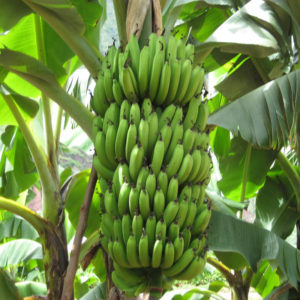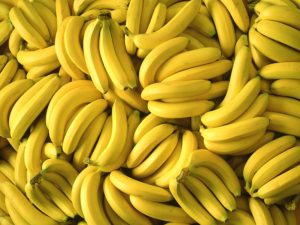General information:
Banana is the second most important fruit crop of India next to mango. It is available round the year and because of its taste, nutritive and medicinal value. It is favorite fruit of all classes of people. It is a rich source of carbohydrate and vitamins particularly vitamin B. Banana helps to reduce the risk of heart diseases. Also, it is recommended for patients suffering from high arthritis, blood pressure, ulcer, gastroenteritis and kidney disorders. From banana, various products are made such as chips, banana puree, jam, jelly, juice, etc. Banana fibre is used to make items like bags, pots and wall hangers. Rope and good quality paper can be prepared from banana waste. In India, banana ranks first in production and third in the area among fruit crops. Within India, Maharashtra has the highest productivity. The other major banana producing states are Karnataka, Gujarat, Andhra Pradesh and Assam.
Soil:
It is grown in variety of soils ranging from poorest to the richest type of soils such as deep silty, clay, loam and rich loamy soil is suited best for banana farming. The soil having pH 6-7.5 is preferred for banana cultivation. For banana growing, select soil having good drainage, adequate fertility, and moisture capacity. Soils which are rich in nitrogen content and have adequate phosphorus content and high level of potash are good for banana cultivation. Avoid waterlogged, poor aerated and nutritionally deficient soils. Also avoid sandy, saline, calcareous and extremely clayey soils.
Popular varieties with yield :
Grand Naine: Released in 2008 and is suited best for growing in Asia. It bears average 25-30kg bunch.
Other state varieties:
Red Banana, Safed Velachi, Basarai, Rasthali, Dwarf Cavendish, Robusta, Poovan, Nendran, Ardhapuri, Nyali.

Land preparation:
Plough the land thoroughly atleast for 3-4 times in summer. At the time of last ploughing add about 10 tonnes of well rotten FYM or well decomposed cow dung and mix it well in soil. To level soil used blade harrow or laser leveler. In areas where nematode problem is prevalent, nematicides and fumigants are also added to pits before planting.
Sowing:
Time of sowing
Mid-February to first week of March is best time for sowing.
Spacing
In north India, coastal belt and areas having high humidity and low temperature i.e. below 5-7°C, the planting distance should not be less than 1.8m x 1.8m.
Sowing Depth
Banana sucker is planted in a pit size of 45cm x 45cm x 45cm or 60x60x60cm. Pits are left open in sun; it will help in killing the harmful insects. Fill pits with topsoil mixed with 10kg of FYM or well decomposed cow dung, Neem cake@250gm and Carbofuran@20gm. Plant suckers in the center of the pit and gently pressed the soil around it. Avoid deep planting.
Method of Sowing
Transplanting method is used for sowing.
 Seed:
Seed:
Seed Rate:
If the spacing of 1.8x1.5m is adopted, near about 1452plants fits per acre. For spacing of 2mx2.5m, 800plants are accommodated in one acre.
Seed Treatment:
For planting, use healthy and uninfected sucker or rhizomes. Before planting, wash suckers and then dip in a solution of Chlorpyrifos 20EC@ 2.5ml/Litre of water. To protect the crop from rhizome weevil, before planting, dip suckers in Carbofuran 3%CG@33gm/sucker after then dry them in shade for 72 hours. To prevent suckers from nematode attacked, treat suckers with Carbofuran 3%CG@50gm/sucker. For fusarium wilt control, dip suckers in Carbendazim @2gm/litre of water solution for about 15–20 minutes.
Fertilizer:
Fertilizer Requirement (gm/tree)
MONTH
UREA DAP MOP
February-March - 190 -
March 60 - 60
June 60 - 60
July 80 - 70
August 80 - 80
September 80 - 80Application of urea@450gm (Nitrogen@200gm) and MOP@350g (K2O@210gm) is done in 5 equal splits.
Weed control:
Remove weeds before planting by deep ploughing and cross harrowing. Take pre-emergence application of Diuron 80% WP@800gm/150Litre of water/acre, if infestation by the weed species.
Irrigation:
Banana is a shallow rooted crop requires large quantity of water for increasing productivity. Overall it requires 70-75 irrigations for good yield. Provide irrigation at an interval of 7-8days in winter where as in summer provide irrigation at an interval of 4-5days. In the rainy season, provide irrigation if required. Remove excess water from the field as it will affect plant establishment and growth.
Advance irrigation technology like drip irrigation can be used. Research shows that use of drip irrigation in banana saves about 58% of water and increasing yield by 23-32%. In drip irrigation, apply water@5-10 litres/plant/day from planting to 4th month, 10-15 litres/plant/day from 5th to shooting and 15 litres /plant/day from shooting to till 15 days prior to harvest.
Plant protection:
Pest and their control:
Corm weevil: If the infestation of corm weevil is observed, then to control, apply Carbaryl@10– 20gm/plant in the soil around the stem.
Rhizome weevil: As a preventive measure, remove dried leaves and keep the orchards clean. Dip the rhizome in Methyl oxydemeton@2ml/Litre of solution before planting. Apply castor cake@250gm or Carbaryl@50gm or Phorate@10gm per pit before planting.
Banana aphid: If the infestation is observed, take spray of Methyl demeton@2ml/litre or Dimethoate 30EC@2ml/litre of water.
Thrips and Lace wing bugs: Take spray of Methyl demeton 20EC@2ml/litre of water or Monocrotophos 36 WSC@2ml/litre of water.
Nematode: To prevent suckers from nematode attacked, treat suckers with Carbofuran 3%CG@50gm/sucker. If suckers treatment is not done, apply 40gm of Carbofuran around each plant one month after planting.
Disease and their control:
Sigatoka leaf spot: Remove and burn infected leaves. Provide proper drainage in the field to avoid waterlogging conditions.
Take spray of any one of fungicides i.e Carbendazim@2gm/litre or Mancozeb@2gm/litre or Copper [email protected]/litre or Ziram@2ml/litre of water or Chlorothalonil@2gm/litre of water. Add 5ml of wetting agent like Sandovit, Teepol etc. per 10 litres of spray fluid.
Anthracnose: If the infestation is observed, take spray Copperoxychloride @2.5gram/Litre or Bordeaux mixture@10gram/Litre or chlorothalonil fungicide @2gm/litre or Carbendazim@3gm/Litre of water.
Panama Disease: If infection observed in the field, uproot and destroy severely affected plants away from the field. Then apply lime@1 – 2 kg in the pits.
Before planting dipped suckers in Carbendazim@2gm/Litre of water. Also, do bi-monthly drenching of Carbendazim starting six months after planting.
Fusarium wilt: Remove of infected trees and apply lime @1-2 Kg/pit.
Do capsule application of Carbendazim@60mg/capsule/tree on 2nd, 4th and 6th month after planting. Do spot drenching of Carbendazim@2gm/Litre of water.
Bunchy Top: It is caused due to aphid infestation, Removed and burn diseased plant parts away from the field. If infestation of aphid is observed, spraying of Dimethoate@20ml/10Litre of water.
Harvesting:
The crop is ready for harvesting 11-12months after planting. Carry out harvesting when banana is slightly or fully mature also according to market requirement. For local market, harvest fruits at maturity stage and for long distance transport, harvest fruit at 75-80 % maturity. Whereas for export purpose, carry out harvesting, the day before or the same day of shipment. Harvest fruit early in the day in the summer. In winter, avoid harvesting too early in the morning.
Post harvest:
After harvesting, curing, washing, grading, packaging, storage, transportation and marketing etc., are the main post harvest operations.
Grading is done on basis of size, color, and maturity. Remove small, overripe, damaged and disease infected fruits. Fruits are generally harvested early in the season at a pre-mature stage to capture the market. Then mature fruits are ripened with lower doses of Ethrel for uniform colour development.
